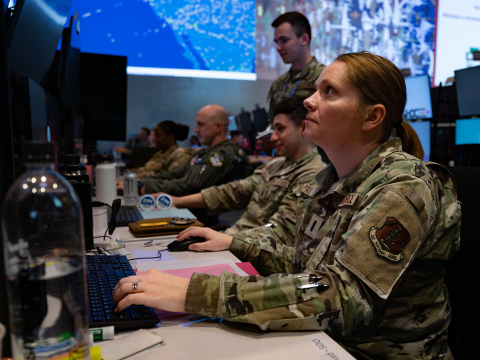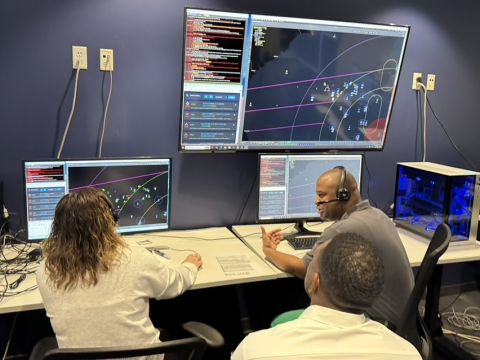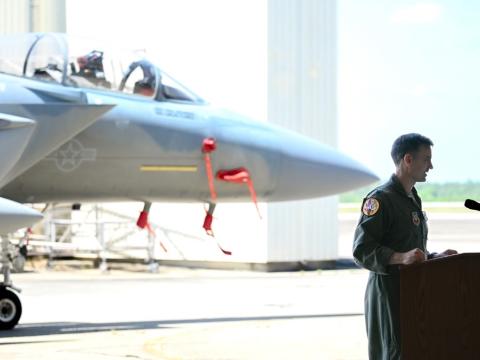Air Force Networkers Link Land, Air, Space
 |
| A Proteus testbed aircraft carries the Global Hawk variant of the U.S. Air Force’s new multiplatform radar technology insertion program radar. The Electronic Systems Center (ESC) program will equip the unmanned aerial vehicle as well as other platforms with a radar that can feed data into the Air Force’s Airborne Network. |
The U.S. Air Force is taking a holistic approach to its information technology upgrades. In addition to networking information, the Air Force is networking its programs to improve interoperability and efficiency.
Many systems under development would either contribute data to the Air Force information realm, move that data across the network or process it for users. Airspace is becoming more complicated as different types of mission-specific aircraft vie for connectivity with a burgeoning number of unmanned aerial vehicles (UAVs), many of which are not part of the Air Force. And, greater involvement in joint or coalition operations complicates efforts to move information in real time.
A key to addressing these concerns is to establish standards, both for technologies and for data itself. Lt. Gen. Charles L. Johnson II, USAF, is the commander of the Electronic Systems Center (ESC), Hanscom Air Force Base,
“None of [these activities] are stand-alone,” the general declares. “They are all very much linked together. Almost everything we do at the
One of the top programs at the ESC is the multiplatform radar technology insertion program, or MPRTIP. This program is a joint effort between Raytheon and Northrop Grumman to produce a scalable radar that can be fitted on different airborne platforms. A version has been delivered to
One goal is to install MPRTIP in a Global Hawk block 40 UAV. This will provide a significant improvement over the existing ground moving target indication (GMTI) synthetic aperture radar, the general warrants. Because the MPRTIP can be installed on Global Hawks, it can cover more of the theater than the limited fleet of Joint Surveillance Target Attack Radar System (JointSTARS) aircraft. And, Global Hawk-equipped MPRTIPs can be targeted for specific operations.
Data from an MPRTIP platform would go into the Air Force’s Airborne Network. Some of the network nodes are dedicated specifically for command and control (C2) or intelligence, surveillance and reconnaissance (ISR), while others are nontraditional nodes such as the F-22’s radar. The Air Force is working with the other services to enable connectivity as the network moves data from its diverse sources.
The Air Force’s multiplatform common datalink, or MPCDL, serves as a series of datalinks to provide interservice connectivity. The family of beyond-line-of-sight terminals, or FAB-T, program aims to provide wideband satellite links between space platforms and air and ground terminals. Gen. Johnson notes that the ESC is working with the Air Force Space and
One urgent need addresses the different architectures established over the years with the components that are composing the Global Information Grid. These programs of record must migrate to common standard architectures that are more conducive to network-centric operations. This will require standard data strategies, and the general cites one such effort designed to aid the U.S. Strategic Command (STRATCOM). The command features several joint force component commanders, two of which are Air Force: the 14th Air Force with the Joint Space Operations Center (JSPOC) and the 8th Air Force for global strike and integration.
Gen. Johnson relates that STRATCOM requested the ESC to serve as its integrator. High on the command’s list was helping the commander and the joint force component commanders access data and information outside of their immediate realm. Making the data discoverable, visible and accessible is the ESC’s goal, he reports.
The ESC is working with the Office of the Assistant Secretary of Defense for Networks and Information Integration on data standards. That office has been busy establishing data standards, and the ESC aims to build on that work. “As we now migrate architectures to help give us network-centric operations, how do we also migrate all of the different data strategies out there across the major commands and the combatant commands so that the owners of the data get the data tagged right?” the general asks.
A user must be able to discover that relevant data exists, and then the user must determine what the data comprises. Gen. Johnson likens it to a Google-type operation. A commanding general or one of his staff must find either dated information that is stored or is streaming in real time. Then, that information in turn may need to be distributed to whomever the commander believes must have it.
In addition to solving this challenge for STRATCOM, the ESC must create a user-defined operational picture for the commander. In this case, the customer must determine how the data should be displayed and manipulated. Gen. Johnson describes it as a huge step that is critically important in the network-centric military.
Another key program is Cursor on Target (SIGNAL Magazine, February 2005). Describing the name as a misnomer, Gen. Johnson says that the software assembled for it offers much more capability. The simple software package will allow many different organizations, including some outside of the U.S. Defense Department, to move data across areas of interest. Homeland security experts, for example, have adopted its approach as an easy way to move data.
And, above all, network security is paramount. Saying, “cyberspace is like a battlefield,” Gen. Johnson emphasizes that the ESC is active in cryptography. Its efforts represent a substantial leap from traditional black box approaches that were installed on platforms or literally carried by crew members. The center is leveraging software to serve crypto needs, and it is working closely with the National Security Agency and other agencies. “You name it, and we seem to be involved with it when it comes to anything crypto out there,” he states.
Modernization is at the forefront of many of these security efforts. “We’ve got some pretty old crypto out there that we’re trying to get rid of. It’s becoming outdated, and the bad guys are able to decode,” the general allows.
All of these disciplines come together in Air Force operations centers, and one of the biggest Air Force networking efforts involves the service’s air and space operations centers, or AOCs. The Air Force is bringing its 23 AOCs into the network-centric realm through its $2.3 billion AOC Weapon System Integrator (WSI) program. By treating the AOCs as a weapon system, the Air Force aims to ensure interoperability across the spectrum of operations—including with non-Air Force organizations.
 |
| The Falconer air and space operations center (AOC) in Ramstein Air Base, Germany, is one of five Falconers in the Air Force. These AOCs are serving as the baseline for the Air Force’s AOC Weapon System Integrator program, which will standardize all 23 AOCs worldwide. |
“There are a lot of applications inside these AOCs, a lot of different companies—a lot of different ‘differents,’” he says.
So the AOC WSI program has two key focus areas: modernization and standardization. “It will not do us any good, especially in this global aspect of operations, if one [AOC] has this kind of standard and one has another,” the general points out.
AOC standardization began with the Falconer effort, which was initiated by former Air Force Chief of Staff Gen. John P. Jumper, USAF (Ret.). Gen. Jumper wanted a standard configuration for the AOCs, which was labeled Falconer. Five AOCs are Falconers, and they are tasked with waging warfighting air campaigns overseas. They are located at the U.S. Central Command Air Forces in
Two others are key functional AOCs that interoperate with the Falconers. These are located at the 14th Air Force and its JSPOC at Vandenberg Air Force Base,
Four other facilities are characterized as Falconer tailored AOCs. These include the 8th Air Force at Barksdale Air Force Base, Louisiana, which is responsible for STRATCOM’s strike mission; the 1st Air Force at Tyndall Air Force Base, Florida, which supports the U.S. Northern Command with air defense for the continental United States; a facility at Hurlburt Field, Florida, for the U.S. Special Operations Command; and the 11th Air Force for homeland defense operations at Elmendorf Air Force Base, Alaska.
Cyber operations are a part of the AOC WSI effort. Gen. Johnson notes that the 8th Air Force commander will lead the deeper Air Force move into cyberspace operations. Cyberspace warfare operations could grow as space operations have, he suggests.
The other 12 AOCs encompass training, support and Air Guard functions. All 23 AOCs worldwide are part of the WSI effort. The Air Force is considering consolidating some of the smaller AOCs to reduce the overall number of AOCs, Gen. Johnson offers.
The major challenge facing the AOC WSI program is its complexity, Gen. Johnson states. Standardization and modernization must take place in real time. This was achieved in the establishment of the Falconer configuration, and the ESC now must keep the AOCs at the same configuration so that they can back up each other. The WSI effort is key to achieving that along with configuration control management and better integration, he emphasizes.
Many Air Force systems traditionally would move data only on a point-to-point basis. The AOC WSI enables machines to move data around the network. “Now you can send it to anyone who has an IP [Internet protocol] address,” the general says. The next big step will be to allow those without an IP address to reach into the network and pull data whenever they want it. This capability is particularly important to STRATCOM with its large and diverse mission area.
Gen. Johnson notes that the new NATO nations are building their own AOC equivalents, and the ESC has been on contract with many of them to help them build smaller scale versions. This is helping to achieve standardization across all of NATO, Gen. Johnson offers. The ESC also is working with the
One common element among all of these international efforts is that the foreign nations want to ensure interoperability with the
Lockheed Martin heads the AOC WSI contractor team. In keeping with the approach of an AOC weapon system, the company has installed a “C2ISR wind tunnel” in its Suffolk, Virginia, Lighthouse Center for Innovation test facility (SIGNAL Magazine, February 2006), according to Lockheed Martin’s John S. Mengucci. He is the vice president and general manager,
Web Resources




Comments